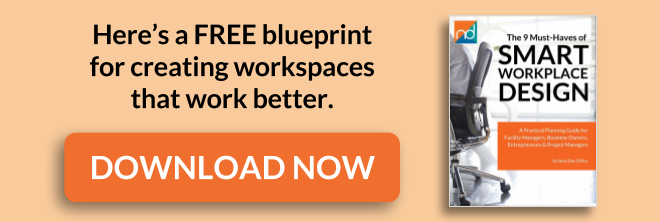5 Reasons Workplace Design is a Powerful Recruiting Tool
By Matt Brady
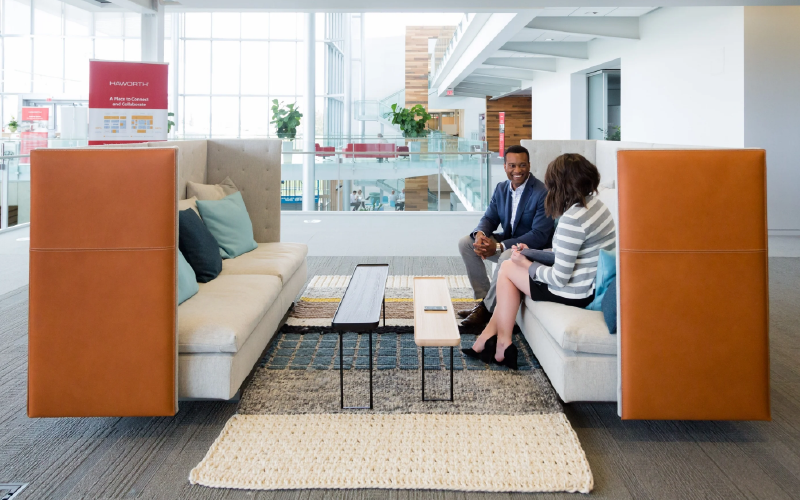
People care about where they work.
Would you ever accept a job offer without having seen the office?
Not likely.
Would you ever commit to full-time employment without knowing where you would spend 40+ hours per week?
I don’t think so.
Workplace design has an impact on top talent. Applicants who are good at what they do are in demand and that means they have choices. If you want them to accept your job offer, you can always make it sweeter.
You can offer more salary. Adding extra benefits is pretty easy too.
But an uninspiring workplace can leave a bad aftertaste that no amount of sweetener can fix.
Turn Your Office into a Talent Magnet
If your company is struggling to attract top talent, it might be worth taking a closer look at your office design and asking some tough questions:
What kind of first impression does your workplace make?
Is it engaging and exciting? Incredibly average? Slightly embarrassing?
Does your workplace tell applicants everything they need to know about your company?
Does it reveal things you’d rather not be known?
and
Is your workplace design a dealmaker or a deal breaker for top talent applicants?
Smart companies are changing the way they think about the workplace. After decades of being treated as cost centers, office spaces are earning respect as revenue generators. Business leaders are learning that investing in great design and smart planning can boost profits by increasing productivity, efficiency and engagement.
Design can also maximize your office ROI by attracting the right kind of employees.
Here are five reasons why great workplace design can supercharge your recruitment efforts…

REASON #1 – Office design matters to millennials.
In the late 1990s, HR experts warned that companies faced an all-out “war for talent.” The nature of business was changing and knowledge workers had become a prized commodity. More available positions and fewer qualified workers signaled a shift in the power dynamic.
Job-seekers gained the upper hand.
At first, big companies didn’t worry. They figured they could just throw bigger salaries at the problem and getting the best people was simply a matter of spending more money. But what they discovered was that this new generation of employees wanted more from their prospective employers… and their prospective workplaces.
Millennials who entered the workforce took their professional spaces more personally. They wanted more flexibility. More choice. More humanity.
Millennials who took jobs at established companies rallied their employers to adapt and evolve. Some of those companies did, but others stuck to their status-quo guns and fought to keep traditional office layouts and old-school aesthetics.
But change always finds a way around resistance.
There are still plenty of companies who choose to ignore the writing on the wall. They try to overlook the fact that the War for Talent and countless tectonic technology shifts have changed the face of business forever.
But here are two big numbers that are hard to overlook:
90% of recruiters say that today’s labor market is candidate-driven.
Millennials make up about 38% of today’s workforce and they’re on track to reach 75% by 2025.
Roughly translated, those numbers mean that any company interested in hiring top-tier talent in the foreseeable future needs to listen and respond to the workplace demands of millennials.
The good news is that making those workplace changes can actually transform your business for the better.
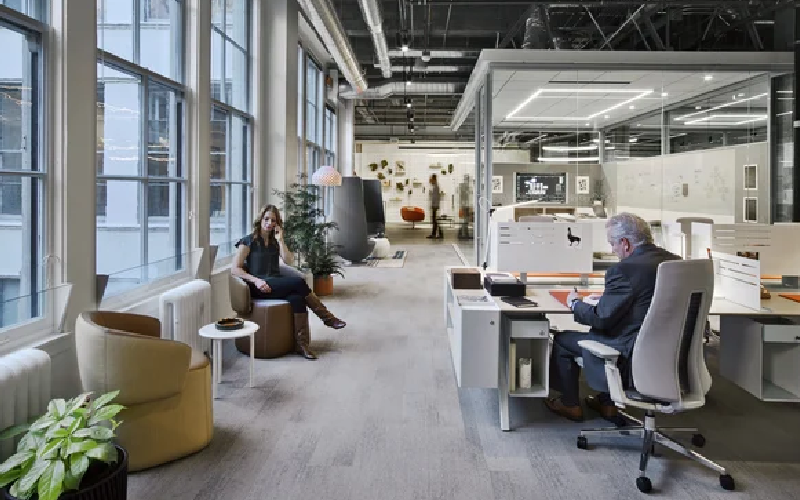
REASON #2 – Great workplace design clearly communicates your brand and culture.
Recruiting talented employees is hard work.
It’s also not cheap. Actual costs vary wildly, but most estimates show that hiring a new employee can cost you thousands of dollars. The tab for replacing an employee can run well into the tens of thousands.
That’s why it makes financial sense to find the right fit the first time around.
Quality candidates are attracted to jobs by salary, benefits and perks. They are motivated by the type of work, the value of the professional experience and even geography. But what might be just as important to the modern worker—and essential in finding the RIGHT FIT candidates—is your company’s culture.
- Does it FEEL like a place they want to work?
- Does it seem like a place where they will fit in?
- Is it inspiring, exciting and innovative?
Candidates can’t get answers from a job posting or a phone call. But nothing communicates your company culture more clearly than your office space.
Great spaces speak for themselves. Good design also speaks to people on basic levels of comfort, aesthetics and emotional well-being.
Having the right space can become a powerful attractor for quality candidates. But uninspiring spaces have the power to repel. if your workplace falls short, it can send applicants running into the arms of your competitors.
If you have doubts that office design really matters to candidates, check out these numbers:
- 21% of workers say they would take a pay cut to work in a nicer workplace (Staples)
- 69% said they would be willing to give up other benefits to work in a well-designed space (CBRE)
- 81% of applicants would reject a job offer if they didn’t like the workplace (Officebroker.com)
- 97% of workers consider their workplace a symbol of whether or not they are valued by their employer (BCO)
Design clearly matters.
When you present a well-designed workplace to the world, it sends a message. It communicates in a sort of visual shorthand and reveals your company’s processes, priorities and personality.
Your workplace speaks volumes about who you are as a company and who you want to be.
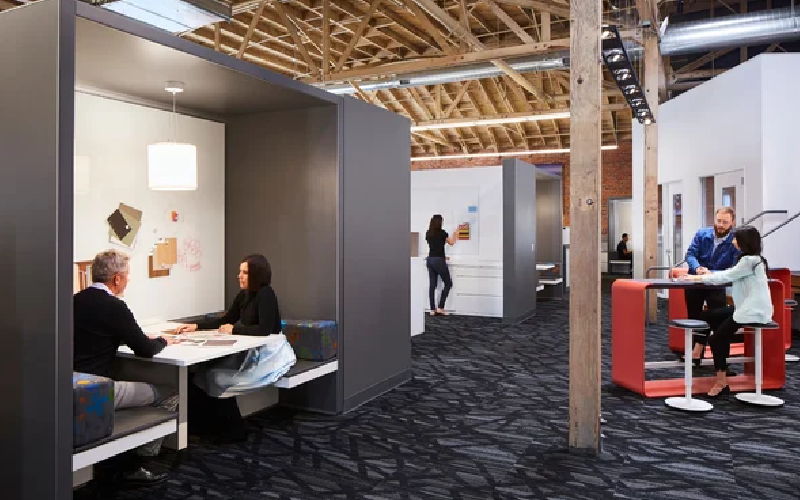
REASON #3 – Great office design helps you stand out.
According to a 2015 Pew Research study, 90% of Americans who looked for work in the last two years used the internet to research jobs. That means that a candidate’s first impression of your business will likely come from your website, a blog article, or even an online review of your company.
What will they see when they Google your business?
The worst answers to that question are a cringe or a shrug… especially when it’s so easy to check for yourself.
This is where companies who understand the value of great design get a clear advantage over those who don’t. The easiest way to deploy a well-designed office as a recruitment tool is by putting photos online.
But before you ask the intern to reach for a smartphone, keep these tips in mind:
Skip the good and take GREAT pictures. Invest in professional photography that showcases your space in (literally) the best possible light.
Include your employees. Show them smiling and engaged in various areas of the office. Unless you are a furniture dealer, avoid posting pictures of vacant spaces. You want to reiterate that this is a place where human beings work.
Use the pictures everywhere. Start with your website. Use them the headers and lead images on all social media platforms. Include them in your Google business listing. Distribute them or make them readily available to local and national media outlets.
Candid photos count too. Capture quality shots of special events, celebrations, or meetings held at your office. Share them on social media and encourage your employees to share work photos as well. Include candid pictures on your website and include them with any official announcements or PR/news releases.
Great design helps you stand out in the media. Eye-catching offices get noticed, even by those who are not currently looking for a new job.
The strategy here is to establish your company as a great place to work and then keep promoting that fact. There’s no shame in showing off a well-designed workspace and sharing photos can help prospective employees imagine themselves in your space.
Plant the seeds of office envy now and maybe you’ll reap the rewards of top talent later.

REASON #4 – Well-designed workplaces create evangelical employees.
Companies don’t redesign their offices to attract new talent.
They redesign to improve overall productivity, efficiency and employee engagement. The fact that a well-designed space attracts quality candidates is just a happy side effect (one of many that can come from smart workplace design).
That’s the most remarkable aspect of an office design’s recruitment power… it comes as a bonus. And while it may be hard to quantify the cost savings, there’s no denying that promoting your office creates a buzz and helps build a narrative about your brand.
Sharing pictures and videos of your workplace sparks interest and attracts attention, especially if that sharing is done with honest enthusiasm by your employees.
Here’s where more of those happy side effects come into play…
Employees who feel connected to their workplaces are more engaged. According to Gallup research, more engaged teams can see a lift of 20% in productivity and a 40% drop in turnover. Engaged teams do better work and do better overall.
It’s all part of the chain reactions that you trigger once you design a smart workplace.
Think about those “Best Places to Work” competitions. People at those companies look happy and come across as genuine fans of where they work and who they work for.
Is there any better image to project to potential employees?

REASON #5 – Great office design leaves a lasting impression.
Last, but not least, comes the first impression.
Applicants who make it to the interview stage may be nervous, but they aren’t the only ones under scrutiny. That first workplace visit is a key moment for a candidate, especially because it gives them the chance to take your office for a test drive.
Think about that first experience for a candidate. What is it like? Is it warm and welcoming? Or cold and quiet? Is the office layout intuitive or does it feel more like a cluttered labyrinth?
The list of reasons why people accept or reject a job is long and sometimes deeply personal… but looks do matter.
One study revealed some of the top deal breakers for job-seekers:
- 41% of workers were turned off by bad taste in decoration
- 50% of candidates were put off by a bad location
- 38% of respondents were deterred by a lack of natural light
- 32% of people would be influenced by old or broken furniture
- 32% would be turned off by a dirty or unhygienic workplace
Step back and put yourself in the applicant’s shoes. When our brains encounter new spaces, they are flooded with sensory input. Not only do we scan the area visually, but we also process tons of other data including smells and sounds.
This first interaction sets the tone for your professional relationship. The impressions and memories that they take away can surely influence their decision to accept or reject a position.
• Create spaces that are welcoming and a process that helps the candidate feel comfortable.
• Your interview location should be private but perhaps offer a glimpse of the daily office activity.
• Pre-plan any walking tours of the space to help anticipate any “surprises” along the way.
• Whenever possible, schedule some trial work time for the applicant to get a feel for the place by completing an assignment or sitting in on a meeting.
• And since people usually recall the end of an experience more vividly, try to end the tour on a positive note in a unique part of your office. Think about how you want them to feel and what you’d like them to remember.
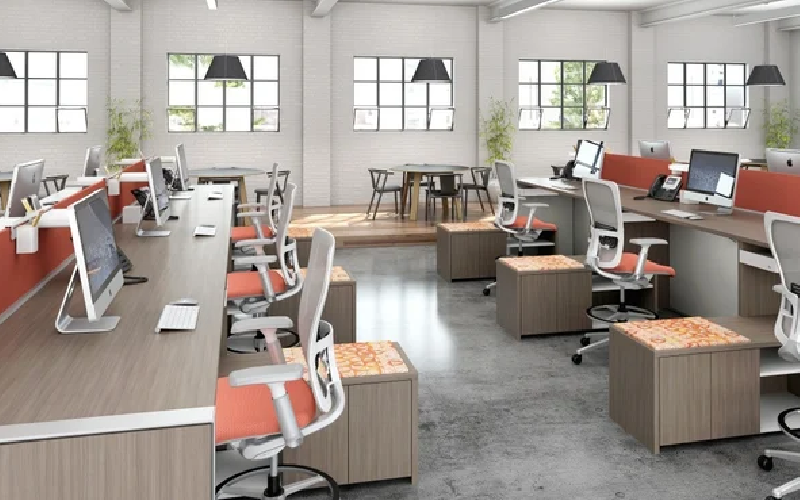
Next step: Make a plan to optimize your workspace
People care about where they work for good reason.
By some estimates, the average adult will spend more than 90,000 hours of their professional life at the office. That’s a little over 10 years spent at a desk, in meetings or working with customers, clients and co-workers.
If you’ve already invested in great workplace design, make sure you’re maximizing the benefits of your powerful recruitment tool. Promote it. Celebrate it. Perfect it.
If your office design needs improvement, it’s probably easier than you think to get started on a plan for creating a space that helps your company work better.
Start by asking yourself some big questions about your business. Begin with strategy and work your way down to the details. Communicate with your leadership and employees. Consult with experts.
Transforming your workspace and reaping the benefits of your investment will take time. But if you build it better, the right candidates will come. A well-designed office will always work harder and smarter and return more value for every dollar you spend.

